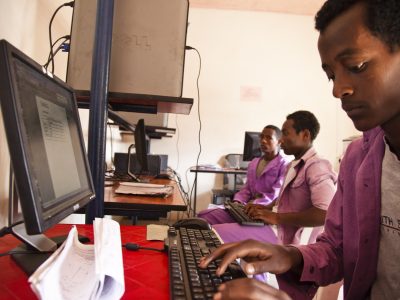In the past year, long-standing conflicts over the contours of the Ethiopian state have once more exploded into violence. Unreconciled disagreements between the state and regional powers in Oromia and Tirgray are revealing competing visions for Ethiopia's national identity.
Over two periods of research, Global Voices identified and analyzed features and patterns of Ethiopia’s media ecosystem—the first in the first half of 2020, and the second from the end of 2020 through March 2021.
Read the full report: A clash of narratives: national identity and violent conflict in Ethiopia
Issues of national and ethnic identity and the Tigray conflict—a major event occurring during the research period—were a key focus of the analysis. For example, the June 29, 2020 assassination of Oromo singer and activist Hachalu Hundessa dominated Ethiopian news and conversation, and resulted in a two-week internet shutdown. Similarly, modes of opposition to the Tigray conflict can been seen in narratives that oppose the ruling Prosperity Party, and discuss ethnic nationalism as a threat to the Ethiopian state.
The study employs research methods based on qualitative analysis of narrative themes and trends in mainstream media, social media, other online media, and offline media. The research does not employ statistical methods nor is the data statistically representative; quantitative statements about the data refer only to the material in the set.
Key observations emerging from this research include the shifting of narratives in response to events of significance, the fragility and dependence of the Ethiopian media infrastructure upon governmental authority, the influence of media created by individuals and organizations in the Ethiopian diaspora, and rapid shifts in narratives around the Tigray conflict.
The data set contains 336 media items and includes over 170 media sources, including editorial media, social media, other online media, and offline media. Media sources also include a range of popular and important broadcasters, news outlets, and prominent social media channels.
Explore the data set: https://airtable.com/shrtOopxJTMCKi1Xm
We identified 47 themes (events, trends or phenomena) and 59 narrative frames (how people and media discuss themes) during this investigation. To better identify patterns and enhance accessibility, the research also presents themes and narrative frames organized under higher-level categories:
Visit the Civic Media Observatory main page
Read related stories
Stories about A clash of narratives: National identity and violent conflict in Ethiopia
Brazilian footballer Vini Jr. pays a painful price for speaking up against racist attacks
Racist attacks against the footballer began in his homeland, Brazil, but increased over the years in Spain, where he plays for Real Madrid.
How the murder of musician Hachalu Hundessa incited violence in Ethiopia: Part II
Within an hour of musician Hachalu Hundessa’s assassination, Ethiopians netizens hit social media with scattershot conspiracy theories, hate speech & disinformation campaigns — particularly on Facebook, Twitter and YouTube.
How the murder of musician Hachalu Hundessa incited violence in Ethiopia: Part I
In the wake of musician Hachalu Hundessa's murder, Ethiopia has struggled to come to terms with the violence and turmoil that erupted along ethnic and religious faultlines.
How identity-driven conflicts fuel Ethiopia's incendiary social media rhetoric
Unity Park aimed to tell the story of all Ethiopians and celebrate the country’s diversity. But social media revealed politicized, nationalistic reactions along ethnic lines: Amhara and Oromo.
In Ethiopia’s disinformation epidemic, the crumbling ruling coalition is the elephant in the room
As acts of communal violence that took place in Oromia in October subsided, a new battle began online over interpretations of the violence — and who was to blame.
How Ethiopia's ruling coalition created a playbook for disinformation
Manipulation tactics used by Ethiopia's ruling coalition members against each other in their internal power struggle serve as a blueprint for opposition groups to attack their opponents and the government.
Months after pledge to open internet, Ethiopia disrupts connectivity amidst communal violence, tension
Ethiopian authorities have resorted to shutting down entire networks in response to recent ethnic and political tensions. A lack of transparency makes it impossible to challenge.
In Ethiopia, disinformation spreads through Facebook live as political tensions rise
Online conspiracy theories, political rants and rumors laced with communal hatred are now common genres in Ethiopian social media.











